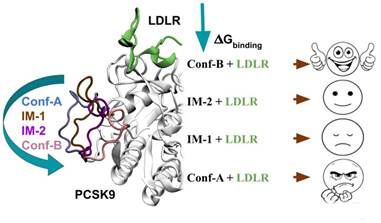Ministry of Science & Technology
Computational protocol provides cheaper route to manage cholesterol levels
प्रविष्टि तिथि:
07 AUG 2024 4:14PM by PIB Delhi
Researchers have explored a new frontier in computer aided drug discovery that can help develop medicines that can prevent harmful protein-protein interactions which can lead to conditions like elevated low-density lipoprotein (LDL) or cholesterol level.
Proteins are vital for our health, helping our bodies perform a wide range of functions. However, sometimes, when proteins interact incorrectly, they can cause several diseases. One of the big challenges in medicine has been to stop these harmful interactions without affecting the beneficial ones.
Traditionally, scientists have tried to develop small molecules as drugs that would preferentially bind to the protein-protein interaction (PPI) sites and act as competitive inhibitors. However, finding drugs that can effectively block these protein interactions has been difficult because the areas where proteins interact are often large and smooth, with no clear spots for a drug to latch onto.
A commonly used alternative approach is to use large peptides or antibodies to inhibit PPIs. But these are often undesirable due to the increased cost, difficulty of storage and mode of administration (injection). So, pharmaceutical industries are always looking for small molecules that are easy to take, usually in pill form.
A promising new approach is to use what are called allosteric inhibitors. These are drugs that bind to a different part of the protein, far from where the main action is happening, but still manage to change the protein's behavior. This can effectively stop harmful interactions. The tricky part is finding these special spots on the proteins to target, which often only appear briefly or are hidden.
This challenging problem has been addressed by the team of Dr. Suman Chakrabarty from S. N. Bose National Centre for Basic Sciences, Kolkata, an autonomous institute under Department of Science and Technology, in collaboration with Sarfez Pharmaceuticals.
In a recently published article in the Journal of Chemical Information and Modelling, they propose a new computational protocol to predict and identify the alternative binding pockets and hotspots on a protein surface that are guaranteed to be allosterically coupled to the functional site (PPI interface) using advanced computer simulation approaches.
As a test case, they have looked at a protein called PCSK9, which plays an important role in controlling cholesterol levels in the blood by interacting with another protein called low density lipoprotein receptor (LDLR). It has been established that an increase in the PCSK9-LDLR interaction can lead to an elevated LDL level, which is a major contributing factor to heart disease.
Although some current treatments help manage cholesterol levels by targeting PCSK9, they can be expensive and not suitable for everyone. That is why finding a small-molecule drug that can be taken orally and block the PCSK9-LDLR interaction effectively could be a game changer.
Team of Dr. Chakrabarty has made exciting progress in identifying parts of PCSK9 protein that can be targeted with these small-molecule drugs. They have used ideas from basic thermodynamics to argue that the bidirectional nature of allostery can be leveraged to identify the allosteric pockets. They show that if binding to a protein (e.g. LDLR) or substrate molecule leads to a conformational change at a distant site of the target protein (e.g. PCSK9), then that conformational change must be connected to the binding affinity.

Essentially, they propose that one needs to compare the conformational ensemble of the bound and unbound states of the protein. Then the unique conformations and pockets that are preferentially present in the unbound system should be targeted for drug discovery. If some small molecules could be identified that can lock the protein conformations in the unbound state, that would lead to inhibition of binding or strength of PPI interaction.
This approach developed in collaboration between an academic research laboratory and a pharmaceutical company is not just about lowering cholesterol—it's about creating a new paradigm to design drugs that can prevent diseases by targeting proteins more cleverly.
Publication: https://doi.org/10.1021/acs.jcim.4c00294
****
KSY/PSM
(रिलीज़ आईडी: 2042649)
आगंतुक पटल : 1268